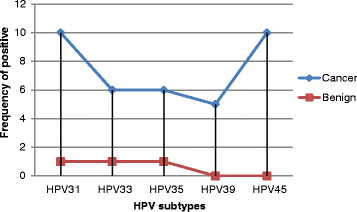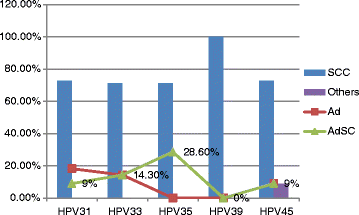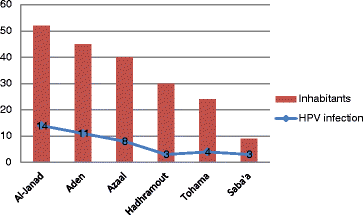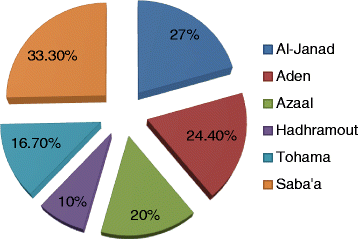Frequency of Human Papilloma Virus (HPV) subtypes 31,33,35,39 and 45 among Yemeni women with cervical cancer
- PMID: 26347799
- PMCID: PMC4561418
- DOI: 10.1186/s13027-015-0026-9
Frequency of Human Papilloma Virus (HPV) subtypes 31,33,35,39 and 45 among Yemeni women with cervical cancer
Abstract
Background: Identification of different HPV subtypes in unidentified communities provides sufficient information for screening and monitoring potential impact of a vaccination program. Therefore, the aim of this study was to screen for the presence of HPVs subtypes 31,33,35,39 and 45 among Yemeni women with Cervical Cancer.
Methodology: A total of 200 (150 malignant and 50 benign) tissue samples were obtained from Yemeni women with cervical cancer, were investigated for the presence of HPV subtypes 31,33,35,39 and 45 by Polymerase Chain Reaction (PCR).
Results: Of the 150 cervical cancer tissue specimens, HPV 31, HPV 33, HPV35, HPV 39 and HPV45 were identified in 10/150 (6.7 %), 6/150 (4 %), 6/150 (4 %), 5/150 (3.3 %) and 10/150 (6.7 %), respectively. The frequency of these HPV subtypes among Yemeni women with cervical cancer was 24 %.
Conclusion: HPV 31, HPV 33, HPV35, HPV 39 and HPV45 were prevalent among Yemeni women with cervical cancer.
Keywords: Cervical cancer; HPV31; HPV33; HPV35; HPV39; HPV45; Yemeni.
Figures
Similar articles
-
Prevalence of Human Papillomavirus subtypes 16 and 18 among Yemeni Patients with Cervical Cancer.Asian Pac J Cancer Prev. 2017 Jun 25;18(6):1543-1548. doi: 10.22034/APJCP.2017.18.6.1543. Asian Pac J Cancer Prev. 2017. PMID: 28669165 Free PMC article.
-
Human papillomavirus (HPV) subtypes and their relationships with cervical smear results in cervical cancer screening: a community-based study from the central Anatolia region of Turkey.Int J Clin Exp Pathol. 2019 Apr 1;12(4):1391-1398. eCollection 2019. Int J Clin Exp Pathol. 2019. PMID: 31933954 Free PMC article.
-
Vaccine-related HPV genotypes in women with and without cervical cancer in Mozambique: burden and potential for prevention.Int J Cancer. 2008 Apr 15;122(8):1901-4. doi: 10.1002/ijc.23292. Int J Cancer. 2008. PMID: 18076064
-
Are 20 human papillomavirus types causing cervical cancer?J Pathol. 2014 Dec;234(4):431-5. doi: 10.1002/path.4424. J Pathol. 2014. PMID: 25124771 Review.
-
Human papilloma virus in oral cancer.J Korean Assoc Oral Maxillofac Surg. 2016 Dec;42(6):327-336. doi: 10.5125/jkaoms.2016.42.6.327. Epub 2016 Dec 27. J Korean Assoc Oral Maxillofac Surg. 2016. PMID: 28053902 Free PMC article. Review.
Cited by
-
Prevalence of Human Papillomavirus subtypes 16 and 18 among Yemeni Patients with Cervical Cancer.Asian Pac J Cancer Prev. 2017 Jun 25;18(6):1543-1548. doi: 10.22034/APJCP.2017.18.6.1543. Asian Pac J Cancer Prev. 2017. PMID: 28669165 Free PMC article.
-
Human Papillomaviruses-Related Cancers: An Update on the Presence and Prevention Strategies in the Middle East and North African Regions.Pathogens. 2022 Nov 19;11(11):1380. doi: 10.3390/pathogens11111380. Pathogens. 2022. PMID: 36422631 Free PMC article. Review.
-
Prevalence and genotype distribution of HPV infection among women in 2021-2023 in southern Iran: The rising trend of HPV infection among women.BMC Womens Health. 2025 Mar 20;25(1):126. doi: 10.1186/s12905-025-03668-5. BMC Womens Health. 2025. PMID: 40114128 Free PMC article.
-
Detection of High-Risk Human Papillomavirus DNA in Invasive Ductal Carcinoma Specimens.Asian Pac J Cancer Prev. 2022 Sep 1;23(9):3201-3207. doi: 10.31557/APJCP.2022.23.9.3201. Asian Pac J Cancer Prev. 2022. PMID: 36172685 Free PMC article.
-
Effect of paiteling on human papillomavirus infection of the cervix.Mol Clin Oncol. 2017 Dec;7(6):957-964. doi: 10.3892/mco.2017.1454. Epub 2017 Oct 17. Mol Clin Oncol. 2017. PMID: 29285356 Free PMC article.
References
-
- Mu Mu Shwe, Kyi Kyi Nyunt, Okada S, Harano T, Hlaing Myat Thu, Hla Myat Mo Mo, et al. Trend of human papillomavirus genotypes in cervical neoplasia observed in a newly developing township in Yangon, Myanmar. Acta Med Okayama. 2015;69(1):51–8. - PubMed
-
- WHO (World Health Organization) Publication. Comprehensive cervical cancer control: a guide to essential practice. 2nd ed. 24. 2014. - PubMed
-
- Clifford GM, Rana RK, Franceschi S, Smith JS, Gough G, Pimenta JM. Human papilloma virus genotype distribution in low-grade cervical lesions: comparison by geographic region and with cervical cancer. Cancer Epidemiol Biomarkers Prev. 2005;14(5):1157–64. doi: 10.1158/1055-9965.EPI-04-0812. - DOI - PubMed
LinkOut - more resources
Full Text Sources
Other Literature Sources





